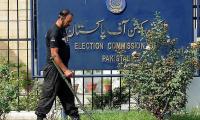KARACHI: The rupee registered its largest single-day gain in almost two months on Tuesday after Pakistan struck a deal with the International Monetary Fund, evoking an optimistic sentiment that the bailout will unlock further bilateral and multilateral financing for the debt-ridden country’s economy.
The rupee climbed 3.83 percent to 275.44 per dollar in the interbank market when the local market reopened following a four-day Eidul Azha holidays, according to the data from the State Bank of Pakistan.
The local currency rose by 10.55 rupees, marking its highest single-day gain since May 12, when the currency appreciated by 13.85 rupees or 4.86 percent against the dollar, according to Karachi-based brokerage house Arif Habib Limited.
Similarly, the currency gained 10 rupees to settle at 280 to the dollar in the open market.
“Currency appreciated as Pakistan signed a staff-level agreement with the IMF for $3 billion Standby Agreement over the weekend. The new programme was a positive surprise and markets reacted accordingly,” said Tahir Abbas, the head of research at Arif Habib Limited.
A dramatic improvement in the financial climate has been brought about by the IMF agreement. On Monday, stocks celebrated the IMF deal with their largest increase in 15 years, while dollar bonds have been on the rise.
“Pakistan 2024 Eurobond price at one year high of close to 80 cents,” said Mohammed Sohail, the CEO of Topline Securities.
Analysts said the IMF financing for nine months aids in regaining some investor confidence. Following the signing of this new agreement, funding from Saudi Arabia, the United Arab Emirates and other bilateral and multilateral sources will start to flow in. Additionally, this will help increase the nation’s foreign exchange reserves, which are now at $4 billion, just enough to cover one month’s worth of imports.
“USD opened at around Rs270 level, with bids going as low as Rs268, but closed at Rs275 level. Since New York was closed, more impact may be seen on Wednesday. Thereafter, movement in reserves and inflows from friendly countries will direct the market,” said Komal Mansoor, the head of research at Tresmark.
However, there is still a lot of work to be done in order to uphold the IMF deal and guide the economy towards recovery. Nine guarantees are included in the letter of intent that the government has signed with the IMF. These include a pledge to refrain from introducing any amnesty programmes for a period of nine months, raise tax revenues, implement financial discipline, start energy reforms, let the market decide the exchange rate, lift trade restrictions, honour commitments made to lending nations and institutions, increase foreign exchange reserves and implement state institution reforms.
Although, the near-term default risk for Pakistan has significantly decreased, analysts are nonetheless worried about the medium-term prospects. As Pakistan faces $25 billion in debt repayments in the year beginning in July, Moody’s Investors Service and Fitch Ratings perceive persistent dangers to the country’s financial stability.
“Pakistan will require significant additional financing besides the IMF disbursements to meet its debt maturities and finance an economic recovery,” said Krisjanis Krustins, director of sovereigns for APAC at Fitch. “While the IMF likely sought and received assurances for such financing, there is a risk that this could prove insufficient, particularly if current account deficits widen again.”
Meanwhile, State Bank of Pakistan Governor Jameel Ahmad said that the staff-level agreement between Pakistan and the International Monetary Fund will help the country address its challenges with inflation and external debt.
He also stated that the medium-term inflation target will be 5 to 7 percent, highlighting the fact that efforts are being made to bring the inflation number to this range in the coming two years.
Due to the IMF bailout, the markets would be more stable, and it will benefit the country’s foreign exchange reserves, Ahmad told the media as he unveiled the Rs75 banknote to commemorate the founding of SBP 75 years ago.
“The rate of inflation has decreased, and over the next two years, we will bring it down to the medium-term target of 5 to 7 percent,” he said.
“Price stability is the SBP’s main objective, and it is also our prime responsibility,” he added.
The SBP raised its benchmark interest rate by 100 basis points to a record 22 percent in an emergency meeting last month. In its monetary policy statement, the central bank stated that the increase in the policy rate would help further anchor inflation expectations – which are already moderating over the last few months, and support bringing down inflation towards the medium term target of 5–7 percent by the end of FY25, barring any unforeseen developments.
The governor spoke about the Strategic Plan SBP Vision 2028, outlining key areas that the SBP will focus on during this period. These include bringing inflation to the target level in the medium term, promoting fairness in the banking system, propagating gender-inclusive policies, encouraging green financing, providing a conducive environment for Shariah-compliant banking in line with the directives of the Federal Shariah Court, and transforming the SBP into a high-tech, people-centric institution. He expressed the hope that the whole banking industry would work with the SBP in realizing these goals.
“Pakistan paid all of its debts to foreign creditors on time,” the governor SBP said and added the country’s forex reserves remained at $4 billion notwithstanding these payments. “We anticipate improved flows, which would be advantageous.”
Regarding the rupee’s appreciation against the dollar in the interbank market, he claimed that sentiment has improved as a result of increased remittance and export proceeds. “We are hopeful that this will go on.”
He said the SBP would upgrade to Real-Time Gross Payment System.
The SBP also plans to link its payment system with the Arab Monetary Fund’s (AMF) Buna, a cross-border payment system, in an effort to facilitate remittance inflow from Gulf Cooperation Council (GCC) countries, according to reports.
Attaur Rahman, the brother of deceased Faizur Rahman, told officials of the Chota Lahore City Police Station that they...
His claims suggest a strategic move by the BJP, with Modi seemingly positioning Shah as his successor
He has built, with his colleagues, a state-of-the-art cleft hospital in Gujrat
Canadian police earlier this month arrested and charged three Indian men in the city of Edmonton in Alberta
Federal Minister for Housing and Construction Riaz Hussain Pirzada has taken notice of all irregularities and directed...
Senator Dar, who reached Beijing after midnight Sunday, was warmly received by the Chinese leadership







